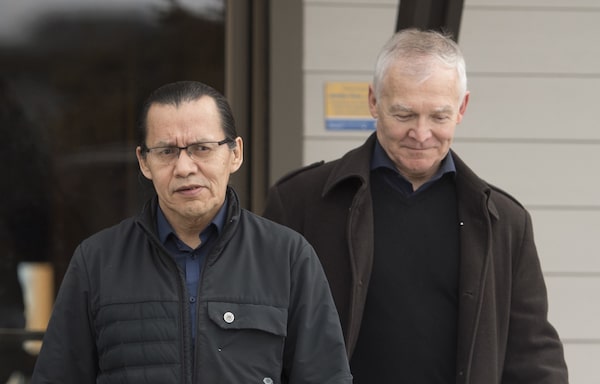When we last left the great pipeline dispute involving the Wet’suwet’en Nation, governments in Ottawa and B.C. were trying to bring calm to an ugly feud that had ignited railway blockades across the country.
Then the COVID-19 pandemic struck, and the imbroglio suddenly seemed like a far less urgent priority.
As it turns out, however, the disagreement that began when a small group of Wet’suwet’en hereditary chiefs and their supporters obstructed construction of the Coastal GasLink pipeline in northern B.C. was not being entirely ignored. On the contrary, an extraordinary deal was being worked out between the two levels of government and a handful of Wet’suwet’en hereditary chiefs that has the capacity to fundamentally alter politics in this country forever.
It also has the potential to be viewed, ultimately, as a horribly one-sided sellout by British Columbia and Ottawa.

Wet'suwet'en hereditary leader Chief Woos, also known as Frank Alec, left, and B.C. Indigenous Relations Minister Scott Fraser arrive to address the media in Smithers, B.C., on March 1, 2020.JONATHAN HAYWARD/The Canadian Press
The details of what the memorandum of understanding – hammered out between the two sides throughout April – entails have largely only been gleaned through leaks to the media. Most controversial among those details: It recognizes and hands power to the hereditary leaders within the Nation, not the elected chiefs. If you’ll recall, it was the hereditary chiefs who opposed the pipeline, while the elected chiefs, in the main, supported its construction as a means of generating revenue that could help lift their communities out of poverty.
According to the hereditary chiefs, this deal, if ratified, would make the Wet’suwet’en the first Indigenous nation in Canada to be recognized as having aboriginal title over its territory – which includes the right to decide on the uses of that land. The two sides have set out a timeline of 12 months to work on the finer details, including areas of jurisdiction. They include child and family wellness, water, wildlife, fish, lands and resources, among others.
On the surface, reasonable Canadians might think that it’s about time. This type of agreement was inevitable, given the courts’ consistent messaging around rights and title. In other words, Ottawa needed to start dealing with the issue, as politically and economically fraught as it might be.
But you would also think that a concession of authority on this level would come with some sort of “in-return” promise by the Wet’suwet’en. But that does not appear to be the case. Asked what they gave up to secure the pact, the hereditary chiefs made it clear in a communiqué to their community: “Absolutely nothing.”
There are so many potential land mines in this agreement, it’s hard to know where to begin. But let’s start with how it gives power to hereditary chiefs over elected chiefs and their councils. In many cases, elected chiefs represent a new generation of Indigenous leadership. The hereditary chiefs who signed this agreement appear to be able to use their new power to stop the pipeline from crossing their land. The way I read this arrangement, the hereditary chiefs will have exclusive domain over natural-resource development.
Hereditary chiefs elsewhere are undoubtedly going to see this agreement as precedent-setting. They will insist on the same powers. And that has the potential to undermine many other royalty-sharing agreements that elected band councils have signed with resource companies.
To summarize: The deal does nothing to solve the Coastal GasLink dispute. The hereditary chiefs had their leadership recognized by government and had to give up nothing in return – including any promise to not continue blocking the pipeline from crossing their territory.
Crystal Smith, the elected chief councillor of the Haisla First Nation who is recognized as one of the most dynamic and progressive-minded young Indigenous leaders in the country, sees the deal creating intractable problems inside the Wet’suwet’en community.
“I think it is a recipe for disaster,” Chief Smith told me over the phone. “I think this is going to sow a lot of dissension and conflict inside their community. It does nothing to solve the deep divisions that are there. They are not going to go magically away.”
The hereditary chiefs face a tough challenge in trying to sell this deal to their community, given the lousy job they did including their people in the talks with government. The elected chiefs, meantime, were effectively shut out of the entire process.
The memorandum requires that a “national reunification plan” be crafted and there be a “stable, defined and transparent” governance regime put in place before there is any transfer of jurisdiction.
That will take a lot of negotiation and give-and-take inside the Wet’suwet’en Nation – way more than was necessary to get the deal done in the first place. Ironically, that’s how this tentative pact could ultimately fail.
Keep your Opinions sharp and informed. Get the Opinion newsletter. Sign up today.
 Gary Mason
Gary Mason